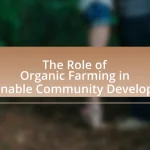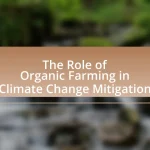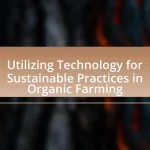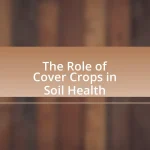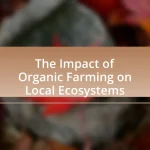Soil microbial communities in organic farming consist of diverse microorganisms, including bacteria, fungi, archaea, and protozoa, which are essential for maintaining soil health and fertility. These communities facilitate nutrient cycling, organic matter decomposition, and disease suppression, thereby enhancing crop yields and resilience. Organic farming practices, such as crop rotation and compost application, promote the diversity and abundance of these microbial populations, leading to improved soil structure and function. The article explores the roles of these microorganisms, their interactions, and the impact of farming practices on microbial communities, while also addressing challenges and strategies for effective management in organic agriculture.
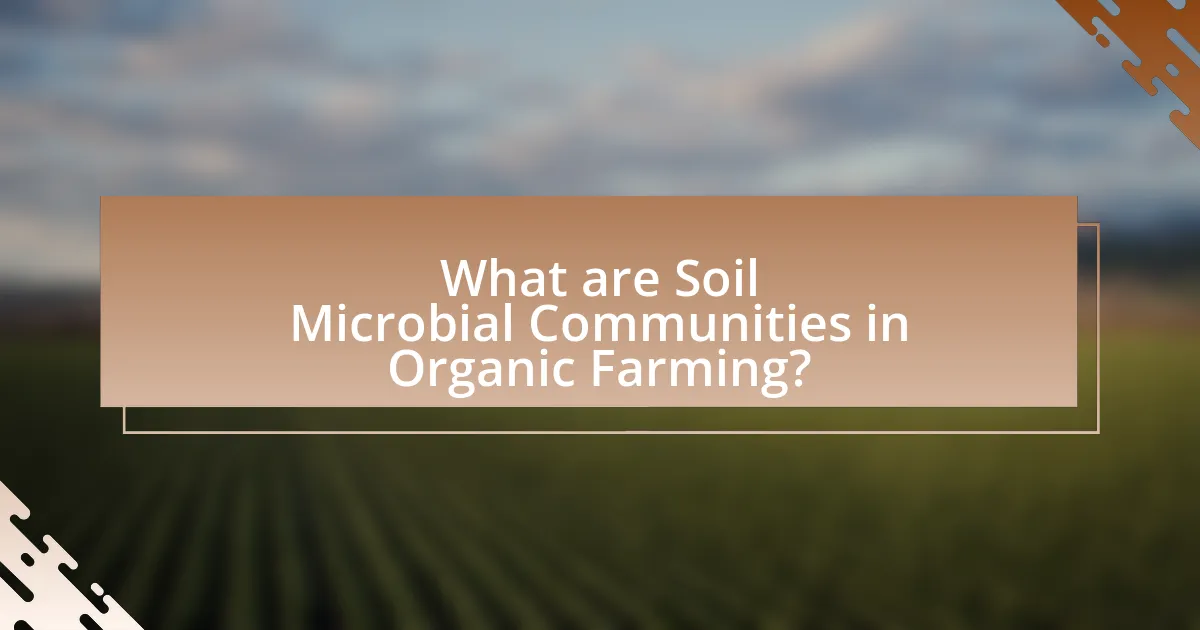
What are Soil Microbial Communities in Organic Farming?
Soil microbial communities in organic farming are diverse groups of microorganisms, including bacteria, fungi, archaea, and protozoa, that play crucial roles in soil health and fertility. These communities contribute to nutrient cycling, organic matter decomposition, and the suppression of soil-borne diseases, which are essential for sustainable agricultural practices. Research indicates that organic farming practices, such as crop rotation and the use of compost, enhance the diversity and abundance of these microbial communities, leading to improved soil structure and function. Studies have shown that healthy soil microbial communities can increase crop yields and resilience against pests and diseases, thereby supporting the overall productivity of organic farming systems.
How do soil microbial communities function in organic farming?
Soil microbial communities function in organic farming by enhancing soil health, nutrient cycling, and plant growth. These communities consist of bacteria, fungi, and other microorganisms that decompose organic matter, releasing essential nutrients like nitrogen and phosphorus into the soil. Research indicates that organic farming practices, such as crop rotation and the use of compost, promote diverse microbial populations, which contribute to improved soil structure and fertility. For instance, a study published in the journal “Soil Biology and Biochemistry” found that organic farming systems had higher microbial biomass and activity compared to conventional systems, leading to better nutrient availability for plants. This dynamic interaction between soil microbes and organic farming practices ultimately supports sustainable agricultural productivity.
What types of microorganisms are present in these communities?
Soil microbial communities in organic farming primarily consist of bacteria, fungi, archaea, and protozoa. Bacteria, such as Rhizobium and Pseudomonas, play crucial roles in nutrient cycling and plant growth promotion. Fungi, including mycorrhizal fungi like Glomus, enhance nutrient uptake for plants. Archaea, often involved in nitrogen cycling, contribute to soil health. Protozoa, such as amoebae, help regulate bacterial populations and nutrient availability. These microorganisms collectively support soil fertility and ecosystem functioning, as evidenced by studies showing increased microbial diversity correlating with improved soil health in organic farming systems.
How do these microorganisms interact with each other?
Microorganisms in soil microbial communities interact with each other through various mechanisms, including competition, cooperation, and signaling. For instance, bacteria may compete for nutrients and space, while fungi can form symbiotic relationships with plants, enhancing nutrient uptake. Additionally, microorganisms communicate through chemical signals, which can influence behaviors such as biofilm formation and resource sharing. Research has shown that these interactions are crucial for maintaining soil health and fertility, as they contribute to nutrient cycling and organic matter decomposition, ultimately supporting plant growth in organic farming systems.
Why are soil microbial communities important for organic farming?
Soil microbial communities are crucial for organic farming because they enhance soil health, nutrient cycling, and plant growth. These communities consist of diverse microorganisms that decompose organic matter, releasing essential nutrients like nitrogen and phosphorus, which are vital for plant development. Research indicates that healthy microbial populations improve soil structure and water retention, leading to increased crop yields. For instance, a study published in the journal “Soil Biology and Biochemistry” found that organic farming systems with rich microbial diversity showed significantly higher soil fertility compared to conventional systems. This evidence underscores the importance of soil microbial communities in promoting sustainable agricultural practices.
What roles do they play in nutrient cycling?
Soil microbial communities play essential roles in nutrient cycling by decomposing organic matter, facilitating nutrient availability, and promoting soil health. These microorganisms break down complex organic materials, such as plant residues and animal waste, into simpler compounds, which releases nutrients like nitrogen, phosphorus, and sulfur into the soil. This process enhances nutrient availability for plants, thereby supporting their growth and productivity. Research indicates that soil microbes contribute significantly to nutrient cycling; for instance, a study published in “Nature” by Bardgett and van der Putten (2014) highlights that microbial diversity is crucial for maintaining ecosystem functions, including nutrient cycling.
How do they contribute to soil health and fertility?
Soil microbial communities contribute to soil health and fertility by enhancing nutrient cycling, improving soil structure, and promoting plant growth. These microorganisms, including bacteria and fungi, decompose organic matter, releasing essential nutrients like nitrogen and phosphorus into the soil, which are vital for plant development. Research indicates that healthy microbial populations can increase soil organic matter content by up to 30%, leading to improved soil structure and water retention. Additionally, certain microbes form symbiotic relationships with plants, such as mycorrhizal fungi, which enhance nutrient uptake and resilience against pathogens. This interplay between soil microbes and plants is crucial for maintaining sustainable agricultural practices and optimizing crop yields.
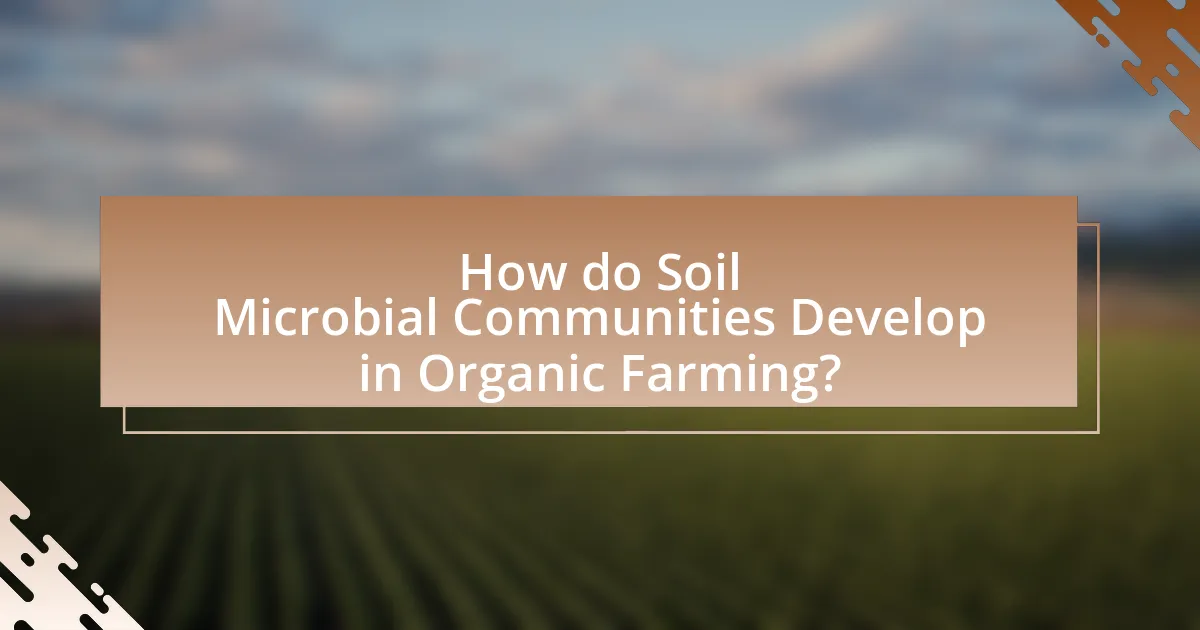
How do Soil Microbial Communities Develop in Organic Farming?
Soil microbial communities in organic farming develop through the enhancement of biodiversity and the establishment of complex interactions among microorganisms. Organic farming practices, such as the use of cover crops, crop rotations, and organic amendments, promote a diverse array of soil organisms by providing varied food sources and habitats. Research indicates that organic farming can increase microbial biomass and diversity compared to conventional methods, as shown in a study published in the journal “Soil Biology and Biochemistry,” which found that organic systems had 30% higher microbial biomass than conventional systems. This increased diversity fosters resilience and stability in microbial communities, ultimately contributing to improved soil health and fertility.
What factors influence the composition of microbial communities?
The composition of microbial communities is influenced by environmental factors, nutrient availability, and land management practices. Environmental factors such as soil pH, moisture, temperature, and organic matter content directly affect microbial diversity and abundance. Nutrient availability, including the presence of carbon, nitrogen, and phosphorus, shapes community structure by favoring certain microbial taxa over others. Additionally, land management practices, such as crop rotation, tillage, and the use of organic amendments, significantly impact microbial community composition by altering soil structure and nutrient dynamics. Studies have shown that organic farming practices enhance microbial diversity compared to conventional methods, indicating that management strategies play a crucial role in shaping these communities.
How does organic matter affect microbial diversity?
Organic matter significantly enhances microbial diversity by providing a variety of substrates that support different microbial communities. The presence of organic matter, such as decomposed plant material and animal residues, creates a rich environment that fosters the growth of diverse microorganisms, including bacteria, fungi, and protozoa. Research indicates that soils with higher organic matter content can support a greater variety of microbial taxa, as evidenced by studies showing that organic amendments increase microbial richness and evenness compared to conventional soils. For instance, a study published in the journal “Soil Biology and Biochemistry” found that organic farming practices, which enhance organic matter levels, lead to a more diverse microbial community structure, promoting ecosystem resilience and functionality.
What environmental conditions are crucial for microbial growth?
Microbial growth is crucially influenced by environmental conditions such as temperature, moisture, pH, and nutrient availability. Temperature affects metabolic rates; most microbes thrive between 20°C and 40°C. Moisture is essential as it facilitates nutrient transport and biochemical reactions; optimal moisture levels typically range from 30% to 70% water-filled pore space in soil. pH levels between 6 and 7 are generally favorable for microbial activity, as extreme acidity or alkalinity can inhibit growth. Nutrient availability, including carbon, nitrogen, and phosphorus, directly impacts microbial proliferation, with organic matter serving as a key nutrient source in organic farming systems. These conditions collectively create a conducive environment for diverse microbial communities, essential for soil health and fertility.
How can farming practices impact these communities?
Farming practices significantly impact soil microbial communities by influencing their diversity, abundance, and functionality. For instance, organic farming practices, which often include crop rotation, cover cropping, and reduced chemical inputs, enhance microbial diversity compared to conventional farming. Research published in the journal “Soil Biology and Biochemistry” by authors such as Tejada et al. (2011) demonstrates that organic farming can increase microbial biomass and activity, leading to improved soil health and nutrient cycling. This enhanced microbial community supports plant growth and resilience, ultimately benefiting the agricultural ecosystem and the communities that rely on it.
What practices promote beneficial microbial populations?
Practices that promote beneficial microbial populations include crop rotation, cover cropping, and the application of organic amendments. Crop rotation enhances soil diversity and disrupts pest cycles, which supports a varied microbial community. Cover cropping, such as planting legumes, adds organic matter and nutrients to the soil, fostering microbial growth. The application of organic amendments, like compost or manure, introduces a wide range of microorganisms and nutrients, improving soil health and microbial activity. Research indicates that these practices can significantly increase microbial biomass and diversity, leading to improved soil fertility and ecosystem resilience.
How do chemical inputs affect microbial communities?
Chemical inputs significantly alter microbial communities by affecting their diversity, composition, and function. For instance, the application of synthetic fertilizers can lead to an increase in specific microbial taxa that thrive on the nutrients provided, while simultaneously suppressing others that are less adapted to high nutrient levels. Research has shown that the use of chemical pesticides can reduce microbial diversity, as certain beneficial microbes are more susceptible to these chemicals, leading to imbalances in soil ecosystems. A study published in the journal “Soil Biology and Biochemistry” found that long-term chemical input usage resulted in decreased microbial biomass and altered community structure, demonstrating the profound impact of these inputs on soil health and microbial dynamics.
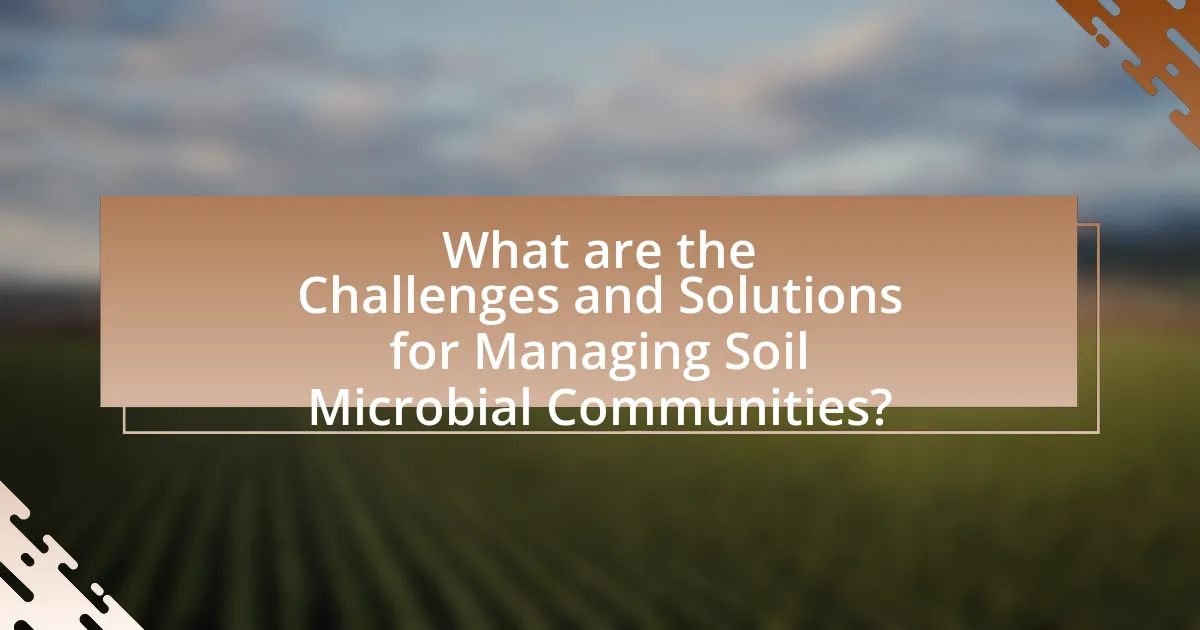
What are the Challenges and Solutions for Managing Soil Microbial Communities?
The challenges for managing soil microbial communities include biodiversity loss, nutrient imbalance, and the impact of agricultural practices. Biodiversity loss can lead to reduced resilience and functionality of microbial communities, while nutrient imbalances can disrupt microbial interactions and soil health. Agricultural practices, such as monoculture and excessive use of chemical fertilizers, can negatively affect microbial diversity and activity.
Solutions to these challenges involve implementing practices that enhance microbial diversity and soil health. Crop rotation and cover cropping can promote biodiversity by introducing different plant species that support various microbial populations. Additionally, organic amendments, such as compost and manure, can improve nutrient availability and foster beneficial microbial interactions. Research indicates that these practices can enhance soil microbial diversity and improve overall soil health, leading to more sustainable agricultural systems.
What common challenges do farmers face regarding soil microbes?
Farmers commonly face challenges such as soil nutrient depletion, microbial diversity loss, and the impact of pesticides on soil microbes. Soil nutrient depletion occurs when crops are harvested without adequate replenishment of nutrients, leading to reduced microbial activity and health. Loss of microbial diversity can result from monoculture practices, which limit the variety of microbes necessary for soil health. Additionally, the use of pesticides can negatively affect beneficial soil microbes, disrupting the ecosystem and impairing soil fertility. These challenges hinder sustainable farming practices and can lead to decreased crop yields.
How can soil degradation impact microbial health?
Soil degradation negatively impacts microbial health by reducing biodiversity and altering community composition. This decline in microbial diversity can lead to decreased soil fertility and impaired ecosystem functions, as diverse microbial communities are essential for nutrient cycling and organic matter decomposition. Research indicates that degraded soils often exhibit lower microbial biomass and activity, which can hinder the soil’s ability to support plant growth and resilience against pests and diseases. For instance, a study published in “Soil Biology and Biochemistry” by Fierer et al. (2012) demonstrated that soil degradation significantly reduced microbial diversity, which is crucial for maintaining soil health and productivity.
What diseases can disrupt microbial communities?
Diseases that can disrupt microbial communities include antibiotic-resistant infections, gastrointestinal diseases, and certain autoimmune disorders. Antibiotic-resistant infections, such as those caused by Methicillin-resistant Staphylococcus aureus (MRSA), can significantly alter microbial diversity by eliminating sensitive bacteria. Gastrointestinal diseases, like Clostridium difficile infection, can lead to dysbiosis, a condition where the balance of microbial communities is disturbed. Autoimmune disorders, such as inflammatory bowel disease, can also affect microbial populations by triggering inflammatory responses that alter the gut microbiome. These disruptions can have cascading effects on soil health and agricultural productivity, as microbial communities play a crucial role in nutrient cycling and soil structure.
What strategies can be employed to enhance microbial communities?
To enhance microbial communities, strategies such as increasing organic matter input, diversifying crop rotations, and minimizing soil disturbance can be employed. Increasing organic matter, through practices like composting and cover cropping, provides essential nutrients and habitat for microbes, thereby promoting their growth and diversity. Diversifying crop rotations introduces various root exudates and organic compounds, which can stimulate different microbial populations and enhance soil health. Minimizing soil disturbance, such as through no-till farming, preserves soil structure and microbial habitats, leading to more stable and resilient microbial communities. Research indicates that these practices can significantly improve microbial diversity and activity, which are crucial for nutrient cycling and soil fertility in organic farming systems.
How can crop rotation benefit soil microbial diversity?
Crop rotation can significantly benefit soil microbial diversity by introducing a variety of plant species that support different microbial communities. This practice enhances nutrient cycling and soil structure, which in turn fosters a more diverse microbial ecosystem. Research indicates that rotating crops can lead to increased populations of beneficial microbes, such as bacteria and fungi, which are essential for soil health. For instance, a study published in the journal “Soil Biology and Biochemistry” found that diverse crop rotations increased microbial biomass and activity compared to monoculture systems, demonstrating the positive impact of crop diversity on microbial communities.
What role do cover crops play in supporting microbial life?
Cover crops play a crucial role in supporting microbial life by enhancing soil health and providing a habitat for diverse microbial communities. These crops contribute organic matter to the soil, which serves as a food source for microorganisms, thereby increasing microbial biomass and activity. Research indicates that cover crops can improve soil structure and moisture retention, creating favorable conditions for microbial growth. For instance, a study published in the journal “Soil Biology and Biochemistry” found that fields with cover crops exhibited higher microbial diversity and activity compared to bare soil, demonstrating their significant impact on soil microbial communities.
What practical tips can farmers use to manage soil microbial communities effectively?
Farmers can manage soil microbial communities effectively by implementing practices such as crop rotation, cover cropping, and reduced tillage. Crop rotation enhances biodiversity and disrupts pest cycles, which can lead to healthier microbial populations. Cover cropping provides organic matter and habitat for beneficial microbes, improving soil structure and nutrient availability. Reduced tillage minimizes soil disturbance, preserving microbial habitats and promoting a stable ecosystem. Research indicates that these practices can significantly enhance soil health and microbial diversity, leading to improved crop yields and resilience against diseases.

